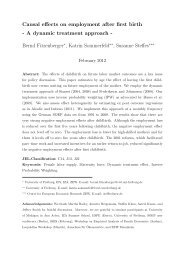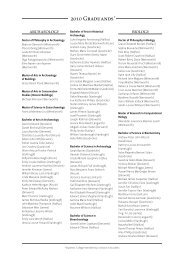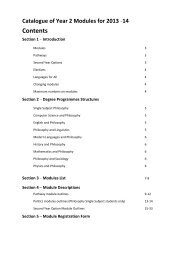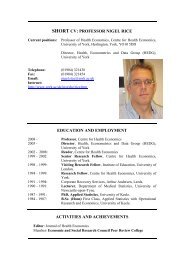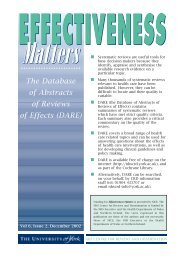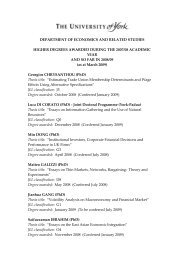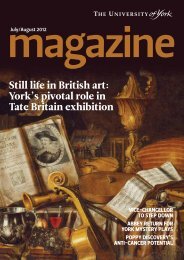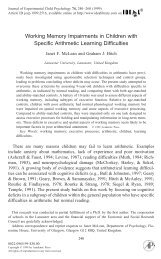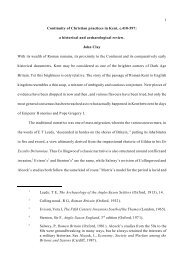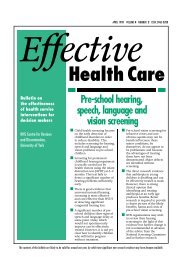05-13 Chem Highlights AMEND:Chem news - University of York
05-13 Chem Highlights AMEND:Chem news - University of York
05-13 Chem Highlights AMEND:Chem news - University of York
You also want an ePaper? Increase the reach of your titles
YUMPU automatically turns print PDFs into web optimized ePapers that Google loves.
2012 research<br />
award winners<br />
Dr Fred Antson<br />
Senior Research Fellowship<br />
Wellcome Trust<br />
Pr<strong>of</strong> Gideon Davies<br />
European Research Council<br />
Advanced Grant<br />
Pr<strong>of</strong> Pratibha Gai<br />
Laureate for Europe<br />
L’OREAL-UNESCO<br />
Women in Science Awards<br />
Pr<strong>of</strong> Ally Lewis<br />
Royal Society <strong>of</strong> <strong>Chem</strong>istry<br />
John Jeyes Award<br />
Dr Kirsty Penkman<br />
Philip Leverhulme Prize<br />
The Leverhulme Trust<br />
Pr<strong>of</strong> David Smith<br />
Royal Society <strong>of</strong> <strong>Chem</strong>istry<br />
Corday-Morgan Prize<br />
Pr<strong>of</strong> Richard Taylor<br />
Royal Society <strong>of</strong> <strong>Chem</strong>istry<br />
RSC Natural Product<br />
<strong>Chem</strong>istry Award<br />
Cantor Nanoscience Lecture<br />
given by Nobel Laureate<br />
On 25 May, Dr Venki Ramakrishnan,<br />
(Nobel Laureate and MRC Laboratory<br />
<strong>of</strong> Molecular Biology, Cambridge) gave<br />
the Cantor Nanoscience lecture: How<br />
antibiotics illuminate ribosome function<br />
and vice versa. In 2000, his laboratory<br />
determined the atomic structure <strong>of</strong> the<br />
30S ribosomal subunit and its complexes<br />
with ligands and antibiotics. This work<br />
has led to insights into how the ribosome<br />
‘reads’ the genetic code, as well as into<br />
various aspects <strong>of</strong> antibiotic function.<br />
For this work, he shared the 2009<br />
Nobel Prize in <strong>Chem</strong>istry.<br />
After the lecture, the Vice Chancellor<br />
awarded a book prize to 3 students who<br />
had performed particularly well in their<br />
first year; Edward Matthews received<br />
the <strong>Chem</strong>istry prize (pictured below).<br />
<strong>Chem</strong> <strong>Highlights</strong> Feb 20<strong>13</strong><br />
Research Funding<br />
<strong>Chem</strong>ists Awarded<br />
£800k EPSRC grant<br />
Pr<strong>of</strong>essors Simon Duckett and<br />
Robin Perutz were recently awarded<br />
an Engineering and Physical Sciences<br />
Research Council (EPSRC) grant worth<br />
£800,000. The grant, entitled “Reaction<br />
monitoring on micro-second timescales<br />
by nuclear magnetic resonance: aiming<br />
for a paradigm shift in the study <strong>of</strong><br />
reaction mechanisms”, will start<br />
in early 20<strong>13</strong> and run for 4 years.<br />
New scanning technology aims to achieve<br />
quicker diagnosis <strong>of</strong> disease<br />
<strong>York</strong> chemist awarded<br />
£480K for s<strong>of</strong>t materials<br />
research<br />
Pr<strong>of</strong>essor David Smith has been<br />
awarded €575,000 as part <strong>of</strong> the<br />
€4.1 million EU-funded network<br />
SMART-NET (S<strong>of</strong>t Materials Advanced<br />
Research and Training Network).<br />
Over the next four years, this network<br />
will support the training <strong>of</strong> 12<br />
PhD students across a network<br />
<strong>of</strong> six universities from the UK,<br />
Netherlands, France, Spain and Italy,<br />
and 3 postdoctoral researchers<br />
based in partner companies and<br />
government agencies.<br />
<strong>York</strong> chemist awarded<br />
£1.8M from MRC<br />
Dr Marek Brzozowski, from our YSBL<br />
group, has been awarded £1.8M from<br />
the Medical Research Council (MRC)<br />
to investigate the interplay between<br />
diabetes and cancer. This is an<br />
interdisciplinary and international<br />
programme that targets the key<br />
molecular contacts at the insulin<br />
receptor complex. The programme<br />
has a two-tier approach combining<br />
fundamental and applied research.<br />
In the very long term, it is envisaged<br />
that the research will be relevant<br />
to experimental and even clinical<br />
intervention <strong>of</strong> both metabolic and<br />
mitogenic (cancer-related) pathways.<br />
Pr<strong>of</strong>essor Simon Duckett is working on new technology that could revolutionise the<br />
way in which Magnetic Resonance Imaging (MRI) scans are used to view the molecular<br />
events behind diseases like Alzheimer’s, without invasive procedure, by increasing<br />
the sensitivity <strong>of</strong> an average hospital scanner by 200,000 times. The technology<br />
underpinning this project, SABRE (Signal Amplification by Reversible Exchange), has<br />
received a £3.6M Strategic Award from the Wellcome Trust. The new grant brings<br />
the total support for SABRE from the Wellcome Trust, the Wolfson Foundation,<br />
Bruker Biospin, the <strong>University</strong> <strong>of</strong> <strong>York</strong> and the Engineering and Physical Sciences<br />
Research Council (EPSRC) to over £12.5M in the last three years.<br />
http://www.york.ac.uk/<strong>news</strong>-and-events/features/hyperpolarisation/<br />
<strong>Chem</strong>ists awarded a<br />
€2.3 million research grant<br />
Pr<strong>of</strong>essors Gideon Davies and<br />
Paul Walton have been awarded a<br />
€2.3 million research grant from the<br />
European Research Agency-Industrial<br />
Biotechnology initiative. The project,<br />
which is led from <strong>York</strong>, has partners in<br />
Copenhagen, Marseille and Cambridge.<br />
It aims to bring together expertise in<br />
molecular biology, inorganic chemistry,<br />
genomics, analysis and industry to<br />
explore the significant opportunities for<br />
bioethanol production created by the<br />
recent discovery <strong>of</strong> GH61 enzymes.<br />
A spacefilling<br />
model <strong>of</strong><br />
ethanol<br />
www.york.ac.uk/<strong>Chem</strong>istry



